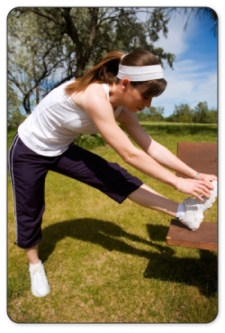The hamstring group of muscles are 3 long muscles (biceps femoris, semitendinosus, and semimembranosus) that cross 2 joints, the hip and the knee. Your hamstring muscles in the back of the thighs, quadriceps muscles in the front, and adductor muscles on the inside of the hips and upper legs are responsible for the legs' multi-directional movements. The hamstring group is primarily responsible for bending the knee and extending the hip. They are used most during running, especially at higher speeds.

Having tight hamstring muscles is a common complaint from runners, and other active people, as well people who sit at a desk all day. When hamstrings tightened up, there is less blood flowing through the muscles which prevents them from working at 100%. By improving blood flow you will loosen your tight muscles, allowing you to use your hamstrings to their full potential.
Limited athletic performance may be a mild consequence of having tight hamstrings, however, a group of tight muscles is more prone to injuries such as strains, pulls, and tears. Tight hamstrings can also cause the pelvis and hips to tilt backward resulting in a flattened lower back and poor posture. This can create problems in the sacroiliac joint or back causing further pain.
To measure the tightness of the hamstring muscles, check the range of your hip flexion. Lay flat on your back and raise your leg off the floor keeping your knee straight. The normal range for hip flexion is 80-90 degrees; if it is less than 80 degrees the hamstring muscles are considered tight.

Tight hamstring muscles do not have many symptoms, however, there may be physical indicators that suggest you have tight hamstring muscles.
Tight hamstring are frustrating to live with especially when trying to run or participate in sports. Regular massaging and stretching of the hamstrings is a great way to loosen the muscles to prevent tightness, as well as preparing them before activity. There are also home treatment options - passive hamstring stretching (assigned by your physician or physical therapist), and most importantly, the Leg TShellz Wrap® - a powerful home treatment tool to heat soft tissue (ie. your hamstring).
Heat from the TShellz Wrap® stimulates local blood flow in the area, temporarily improving the body's localized healing response to help rehab damaged muscles, tendons and ligaments. Heat from a TShellz treatment will increase flexibility and length of your hamstrings and tendons, so if you apply a TShellz Wrap® before activity, you will reduce the risk of straining your hamstrings (and other soft tissue) as the treatment has "warmed them up". Over time, increased stretching without the accompanying re-straining will give you the ability to achieve longer hamstrings, reducing the risk of hamstring muscle injury and chronic tightness.
Learn more about Tight Hamstring Treatments by clicking here
AidYourHamstring advisors do not work on commission, so be assured you will only receive fair and objective information.
Product Advisors are available 9:00 am to 5:00 pm Eastern Standard Time Monday to Friday.
I want to learn more about Surgery & Post-Surgery Recovery
I want to learn more about Circulation Boost
I want to learn more about Ice & Heat: Which Is Better For Treatment?
I want to learn more about Stretching for the Hamstring
I want to learn more about Soft Tissue Injury Treatments
During your recovery, you will probably have to modify and/or eliminate any activities that cause pain or discomfort at the location of your soft tissue injury until the pain and inflammation settle. The more diligent you are with your treatment and rehabilitation, the faster you will see successful results!
Please be aware that this information is neither intended nor implied to be a substitute for professional medical advice. CALL YOUR HEALTHCARE PROVIDER IMMEDIATELY IF YOU THINK YOU MAY HAVE A MEDICAL EMERGENCY. Always seek the advice of your physician or other qualified health provider before using any of our outstanding products to make sure they are right for you and your condition or if you have any questions regarding a medical condition. Always see your doctor for a proper diagnosis as there are often many injuries and conditions (some very serious) that could be the cause of your pain.
© 2025 In.Genu Design Group, Inc. Contact Us